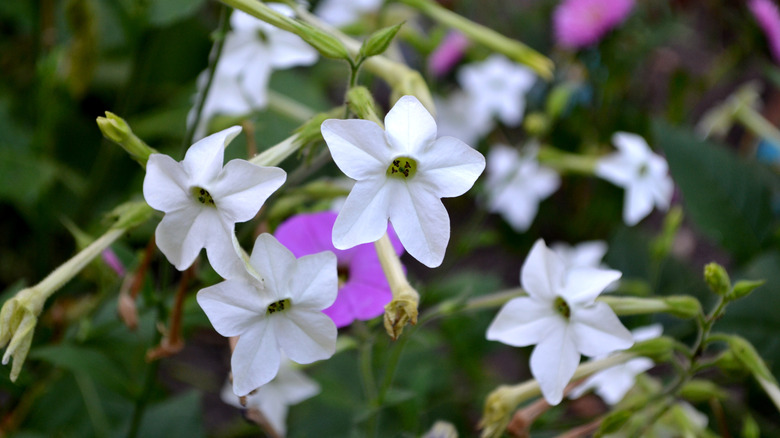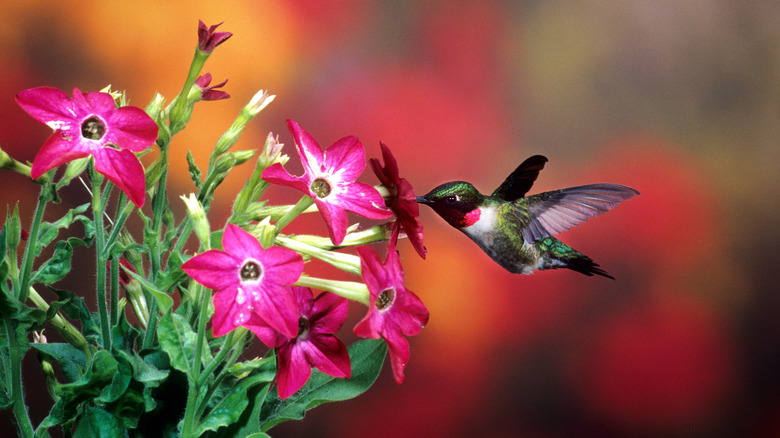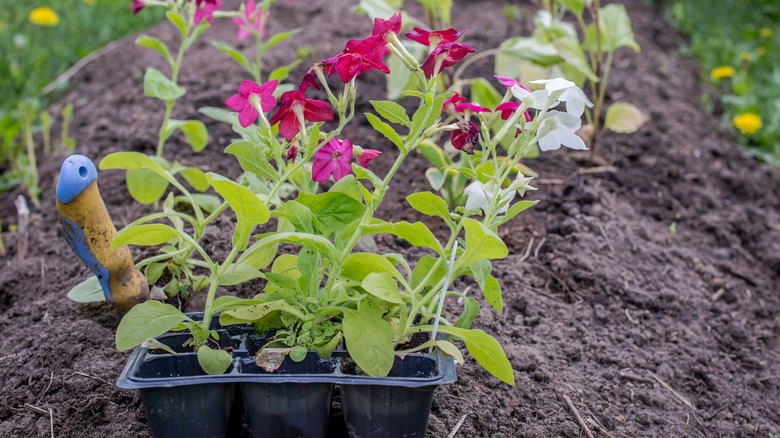Why You Should Consider Planting Flowering Nicotiana In Your Garden
If you're looking for a unique flowering plant that emits an intoxicating evening scent, look no further than flowering nicotiana. There are a few varieties of this striking garden plant, but one of the best choices for a modern garden is Nicotiana alata, also known as flowering nicotiana, flowering tobacco, or jasmine tobacco. This tender perennial is native to South America, but it is non-invasive and does quite well in southern areas of the United States, particularly in USDA zones 10 and 11.
With its vibrant pink, purple, red, green, or white flowers, Nicotiana alata is one of the most stunning plants that bloom at night, and it draws in a host of evening pollinators — and people — with its lovely jasmine-like scent. Plus, this fragrant plant can be surprisingly useful for controlling some common garden pests.
For those who love to spend the evening outdoors or enjoy the scent of fresh flowers from their patio, night-flowering nicotiana can hardly be beat. However, flowering nicotiana isn't a perfect plant for everyone, depending on your location, gardening style, and family. Here are the benefits this plant can bring to your outdoor space, plus some words of caution before investing time and energy into growing this beautiful plant.
Fragrant blooms entice gardeners and pollinators alike
The first benefit that flowering nicotiana can bring to your garden is its stunning appearance and dreamy scent. Today, most commercially available nicotianas are hybrids that come from Nicotiana alata. Individuals can vary, but most of these plants will grow around three to five feet tall. Flowering nicotiana's bright green alternating leaves lend a bushy, fluffy texture to the garden, with tall, flowering stems that tower over the foliage. The original Nicotiana alata plant has pale greenish flowers, but hybrids are available in a rainbow of other shades, like pink, white, and purple. Nicotiana isn't nicknamed "jasmine tobacco" for nothing; these tubular flowers have a very strong and sensual jasmine-like scent that fills the air at night.
Flowering tobacco can also help you attract pollinators and other insects right where you want them. During the day, the flowering nicotiana's blooms may droop and sag, but as evening temperatures start to cool down, they'll perk up and become a veritable buffet for nighttime pollinators. Moths, butterflies, and hummingbirds can't resist this fragrant night-blooming plant. Pollinators will love your flowering nicotiana, but this plant is also useful for controlling unwanted bugs, like aphids, flea beetles, carrot flies, and whiteflies. Flowering nicotiana can be used as a trap plant for these insects, drawing them away from your other garden plants and into one central area that can more easily be treated for pests.
Flowering nicotiana can be finnicky
Nicotiana alata makes an excellent filler plant for gardens, but it can be a little bit picky about its growing conditions. Firstly, flowering nicotiana needs fertile, moist soil with plenty of organic material. It can be grown in containers or rock gardens, but be wary of the soil drying out or losing its nutrients. This plant appreciates full sun to part shade, but it can easily become scorched in the afternoon heat and is not very tolerant of droughts. For this reason, it's best to plant flowering nicotiana where it will get six hours of morning sunlight while receiving cool shade in the afternoons.
If you want to enjoy as many blooms as possible, continue using an organic fertilizer throughout the growing season. Watch out for tobacco mosaic virus, flea beetles, and tobacco hornworms, which can cause damage to this plant.
Visually, flowering nicotiana toes the line between a wildflower and a domestic garden plant, making it a brilliant choice for a luscious cottage garden. However, caution is needed when growing this plant near children or pets. There are many poisonous plants that look beautiful in gardens, including Nicotiana alata. All parts of this plant contain nicotine and can be toxic if ingested. Additionally, because this plant attracts aphids and other pests, you won't want to plant it near your favorite garden plants, but you can use it as a "trap" plant to draw pests away.


